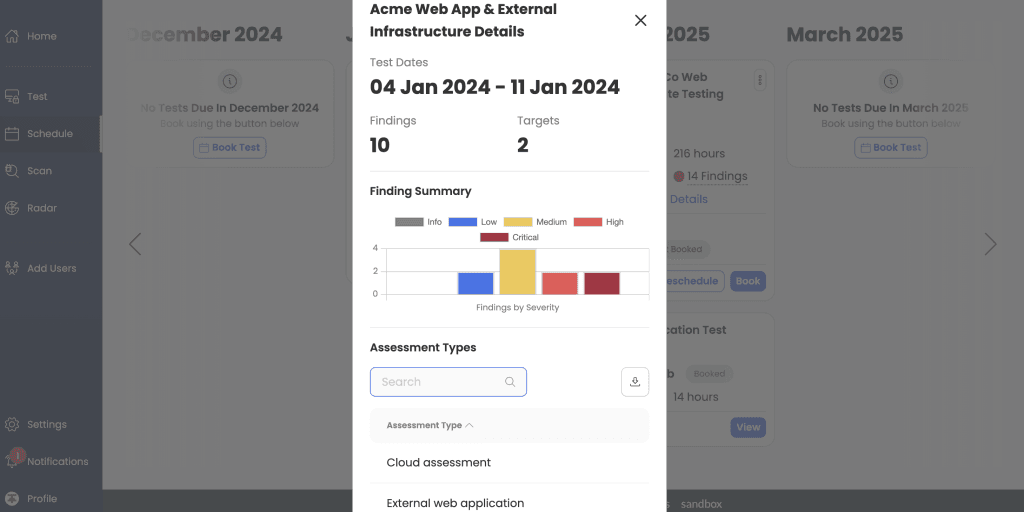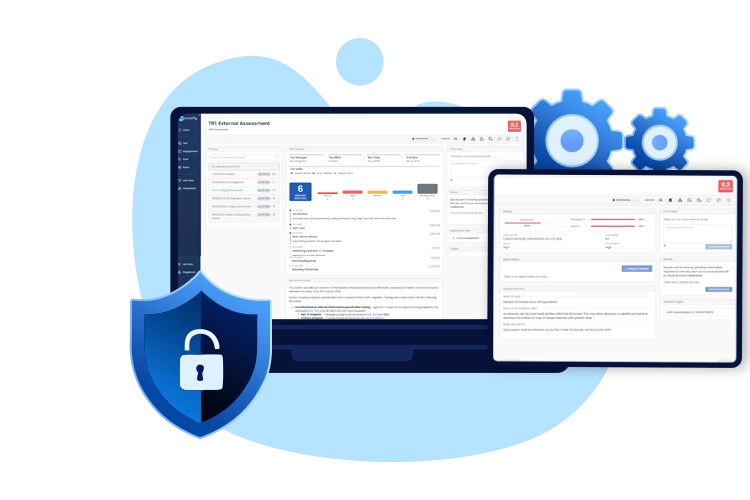External Infrastructure penetration testing
OnSecurity highlights weaknesses within your organisation’s external infrastructure. By proactively addressing potential weaknesses, you can significantly reduce the risk of unauthorised access and safeguard critical systems and data from cyber threats.
What is External network penetration testing?
External network penetration testing involves ethical hacking of your organisation’s internet-facing systems and networks. External systems can include web applications, networks, FTP servers, mail, routers, login systems, and sub-domains. This process simulates the techniques used by real-world attackers to test your defences, identify vulnerabilities, and evaluate your security posture. The key objectives include being able to:
- Discover unpatched systems where outdated software could be exploited.
- Assess insecure configurations that could leave your network exposed.
- Attempt to breach systems by simulating an attack and evaluating of how well your defences hold up.
- Investigate if there are secure authentication mechanisms in place and secure passwords.
- Explore any potential software flaws and ineffective firewall rules.
- Data exfiltration testing and weak encryption protocol testing to see if sensitive data could be extracted by attackers.
- Internal network access attempts by simulating efforts to breach the internal network from the outside. Replicates the techniques real-life attackers use when targeting an organisation.
Why do you need an external network infrastructure pentest?

External network infrastructure is a primary entry point for cybercriminals. Regular pentesting helps identify vulnerabilities like missing patches, weak firewall rules, and misconfigured software before attackers can exploit them. By simulating real-world threats, you can prevent data breaches, service disruptions, and reputational damage, while also demonstrating a commitment to security and compliance with industry regulations. The knowledge of your network’s vulnerabilities puts you in a great place to develop your security measures and better protect yourself against attackers.
Ready to experience the future of pentesting?
Discover how combining expert insight with automation leads to faster, more precise, and high-impact penetration testing.
Crest-accredited external infrastructure pentesting
At OnSecurity, we deliver top-tier penetration testing services, validated by our CREST (Council of Registered Ethical Security Testers) accreditation. This ensures our methodologies, processes, and procedures meet the highest standards in the industry.
Why trust OnSecurity for your external infrastructure pentesting?
- CREST-accredited: Our practices are externally vetted, guaranteeing top-quality testing,
- Certified experts: Most of our testers are CREST-certified, proven in rigorous assessments.
- Manual-first approach: We focus on hands-on testing to catch vulnerabilities automated tools might miss.
Choose OnSecurity for expert-driven, reliable external network security.

External infrastructure security challenges
Securing your external infrastructure presents unique challenges that require specialised knowledge and proactive measures:
Quick, high-quality pentests
Discover why our user-friendly platform and AI + human approach make pentesting hassle- free.
Flexible subscription plans
Simplify your testing and monitoring with a single monthly payment, combining regular penetration tests and continuous vulnerability scanning. Get predictable costs while receiving ongoing protection.
Instant quote & customised plans
Receive a real-time, personalised cost estimate through our intuitive platform. Tailor your testing needs with configurable options that suit your business goals and security requirements.
Effortless platform access
No more long scoping processes. Book tests directly through our platform or get personalised assistance from our sales team. Enjoy streamlined communication and automated workflow notifications for maximum efficiency.
Immediate, actionable reports
Access your findings instantly through our platform. Generate detailed reports at any time, offering both technical insights and high-level summaries—without the wait.
Free retests for resolved issues
Once you’ve addressed vulnerabilities, we’ll retest them for free within a flexible window, ensuring your systems remain secure at no additional cost.
Ongoing protection & threat intelligence
Sign up for continuous monitoring to access automated vulnerability scanning, along with situational awareness through threat intelligence, ensuring your defences stay up to date year-round.
Other Types of penetration testing
Find the penetration test to best suit your business and cybersecurity needs.
Frequently Asked Questions
Got a question you need answering? Our FAQs should help guide you
External pen testing focuses on your organisation’s internet-facing systems, while internal pen testing assesses the security of your internal network and systems, identifying vulnerabilities that could be exploited by insiders or through a compromised external network.
This really depends on the objectives of the test. In a real-world scenario, attackers have unlimited time to bypass the intrusion prevention system (IPS), and once they do, they target the same vulnerabilities a tester would identify in an external penetration test.
If your goal is to assess the effectiveness of your IPS or broader defences, whitelisting isn’t recommended. However, if you’re more interested in discovering which vulnerabilities could be exploited once an attacker bypasses detection, a time-limited test with the tester's IP address whitelisted can provide more value.
The duration of a test depends on the size and functionality of your target. We ask two straightforward scoping questions to assess the complexity of your environment, which helps us estimate the time required for testing.
A pentest should be conducted at least once a year, with additional tests carried out more frequently following any major changes, upgrades or software patches.
Our testers provide updates as they conduct their tests, so you receive notifications that can be integrated through your workflow apps when issues are discovered, rather than waiting until the entire test is complete and a report is generated.
There should be no disruption as our penetration tests are performed carefully and systematically by experienced professionals. We offer the option to conduct tests in UAT, staging, or development environments to minimise any disruption to your operations. Throughout the process, we keep you informed, allowing you to promptly address any security issues as they arise.
The goal of a network penetration test is to identify vulnerabilities before cybercriminals can exploit them. Common issues that may be found include missing patches, poorly configured firewalls, software, and operating systems. Understanding these weaknesses enables you to strengthen your security measures and better protect your network from potential threats.
Web app pen testing finds vulnerabilities within a specific web app, such as issues with input validation, authentication, or security misconfigurations. External network pentesting, however, assesses an organisation's external-facing infrastructure, including servers, firewalls, and network devices. It looks for vulnerabilities like open ports, outdated software, and weak firewall settings that could allow unauthorised access to the internal network.
If your business relies on internet-facing systems, external infrastructure penetration testing is crucial for identifying and mitigating risks before they can be exploited by attackers. This testing is essential for any organisation looking to safeguard its network, protect sensitive data, and maintain a robust security posture.










